
Handball - Quick Guide
Handball - Overview
Handball is one of the most popular games all over the globe. It is mostly played in Germany, Denmark and Sweden, and was professionally initiated as a game at the international level during 19th century, with a first-time demonstration at Summer Olympic of 1952. In order to score a goal, the ball is passed from hand to hand instead of feet, as in the case of football. It can be played both indoors and outdoors. Professional handball playing has different nomenclatures all over the world, such as European team ball, Borden ball, Olympic handball, Team handball etc.
Handball is played on a court with a goal centre at each end of the court. The goal centre is surrounded by a line inside which only goal keeper is permitted. The players pass the ball from hand to hand with the aim of scoring goal without touching or going inside the defending line. The highest scoring team wins the match. In handball the activity happens at a fast pace, be it ball-passing or goal-scoring. Basically, each team scores 20 to 30 goals.
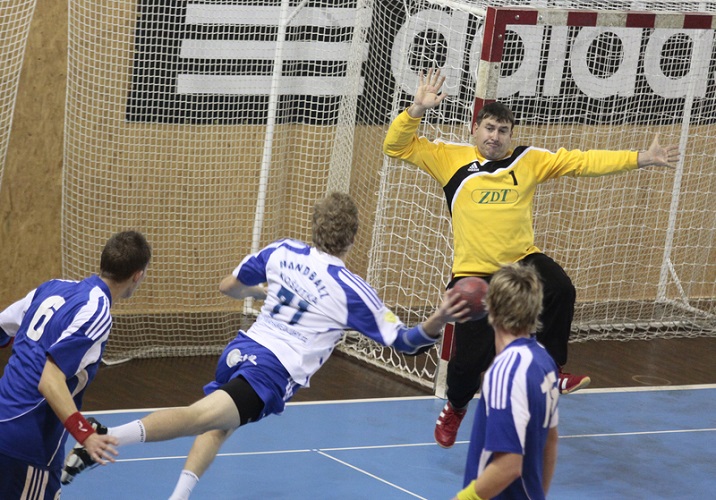
Team Size
Handball is played between two teams of 7 members from each side, including a goal keeper. The goal keeper defends the goal while other six field player attempt to score goals by putting ball into the oppositions goal post. There are many professional handball teams participating in several national and international tournaments that are organised by various organisational bodies over the world.
Participating Countries
Handball has been a popular game all over the globe. Even though it originated in non-Asian countries, it has tremendous popularity in Asian countries. A number of federation has been formed which are conducting handball tournaments at higher level. It was introduced in Asia at the Asian Games of 1982 held at New Delhi. In Asian games, various countries like Japan, China, India, Saudi Arab, Kuwait, Qatar and South Korea participate in Handball, the competition being held once in every four years.
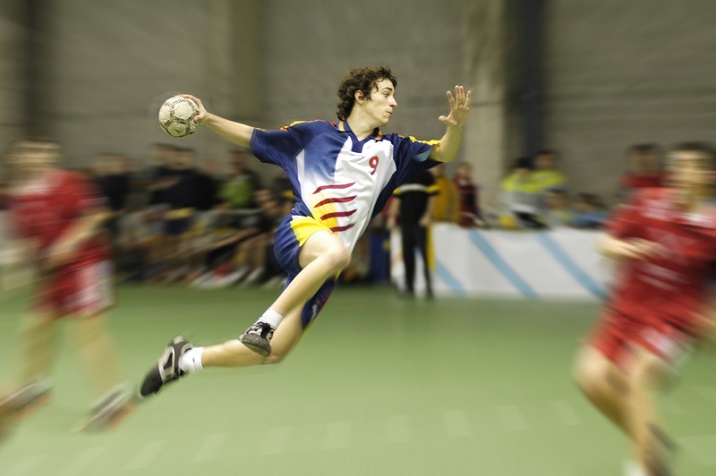
Handball is quite popular in countries such as Germany, Sweden, Berlin, Denmark, Iceland etc. International handball federation (IHF) has been organising various championship tournament for both mens and womens category. IHF is conducting these tournaments since 1946. Slowly, after the games inception, indoor handball evolved and got popular in Scandinavian countries. Since then, it is being played in both indoor and outdoor condition.
Handball - Playing Environment
Handball is being played on a rectangular court in either indoor fashion or on an outdoor grassy field. The game is played between two teams of seven members each. Each team are free to choose the side of the court they wish to play first and the referee decides which team will start the game by tossing process. Like other teams, players can be substituted in place of players on the field according to the rules and regulation governed by IHF.
Court Design of Handball
Handball is played on a rectangular court having dimension of 40mts by 20mts with a goal centre at each side. It has a centre line which equally divides the field into two identical rectangles. In each half of the court there is a goal surrounded by a semi-circular line known as the d-line. The region enclosed by d-line is known as d-zone or crease, where only goal keeper is permitted. Hence a player has to attempt to score goals from outside the d-zone without touching the d-line. Another dashed curve line of 9mts diameter indicates free throw line.
Dimensions of a Handball Field
A handball player must be acquainted with the dimension of various regions of the handball court and the ball used. Basically a handball field is a rectangular shaped area having dimensions as below.
Width and breadth of the handball court is 40mts in length and 20mts in width.
The goal post is 2mts in height and 3mts in width.
A 6mts line known as d-line separates the goal keeper from rest of the players who are not allowed to cross the line.
A mark is provided at a distance of 7mts from the goal post from which penalty shots are taken in case any foul occurs during the handball match.
A player starts the play from a 9mts dashed line in case being fouled inside the opponents line. It is also known as free throw line.
A centre line is also provided which marks the start of the game. It also acts as the reference line of resumption of game after half time. After scoring of goal, game is resumed from that mid line.
Substitution line are marked on the side line of handball through which player must leave the court whenever a substitution is made.
-
Ball size of a handball game varies depending upon whether it is being played under mens category or womens category. Dimension of ball for both category are as follows −
Mens − Weight of ball ranges from 425gm to 475gm and circumference is from 56 to 60 cm.
Womens − Weight of ball is between 325gm to 375gm and circumference is 54 to 56cm.
Handball - Equipment
In Handball, a player uses different equipment which are needed while playing the game. An audience can see the use of the following equipment when game is on. As the game is played in various forms, equipment used by player also varies accordingly.
Ball

Ball used in handball is similar to the volley ball or the balls that are used in football, but nowadays a special type of ball has been made which is tailor-made for easy carrying and passing from hand to hand.
Goal Centre
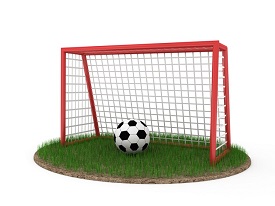
In handball, a goal centre is provided at each end of the court, which is 2mts tall and 3mts wide. The goal centre and the crossbar must be of the same material. Mostly, it is made of aluminium. The colors on both the goal centres must be the same.
Each goal centre must have a net and it must be fastened in such a way that a ball thrown into does not pass the goal.
Gloves

While playing American handball, it is necessary to wear gloves as the manoeuvring of ball needs to be really fast. Players may use some means to protect their eyes from injuries. For example- sun glasses are permitted.
Shoes

There is no definite specification of shoes that a handball player should use.
There are various types of shoes available which can be chosen by a player that will help them to play comfortably and prevent any potential injury.
Handball - Terms
Before getting ready to play handball, one should know its frequently used terms. These are common terms used to describe various activities in handball. Some terms used in professional handball matches are listed below.
Court player − The players playing on the court except goal-keepers are known as court player.
Goalie − A player who defends the goal while opposition attempts to score goals. A goalie or goal keeper is permitted to play inside the goal area.
Corner Throw − This is thrown by attacking player from the corner of court. It is done by throwing the ball by using either hand. A corner throw is given to an attacking player while the ball is played over goal line by a defending player or either side of the goal.
Corner Throw − This is thrown by attacking player from the corner of court. It is done by throwing the ball by using either hand. A corner throw is given to an attacking player while the ball is played over goal line by a defending player or either side of the goal.
Free throw − It is allowed to the opposition team while other team does a foul during the game. The ball is thrown from a line 9mts away from the goal.
Penalty throw − The penalty shot is thrown from a mark at a distance of 7mts from the goal. In a penalty throw a player is allotted to score a goal through direct throw into the goal centre.
Referees throw − This throw is done by referees to resume the game after an interruption of play caused by any other reason than mentioned above, during a handball match.
Dive shot − It is a way of putting the shot, in order to score a goal, by jumping above the floor towards the goal. It is done without touching the d-line.
Goal − A goal is scored by throwing the ball into the goal post and is confirmed by deciding that if the ball has hit the tape mark or not.
Throw-in − It is done by a player by throwing back the ball into the court after it has crossed one of the side lines. While throwing the ball the feet of the player must be in contact with the ground. Player may either use his/her either hands or a single hand to throw the ball.
Throw-on − It is done to start the play or after a goal is scored, from the centre of the court.
Throw out − It is a throw by a goalkeeper from the goal area in order to pass the ball to a team player after possession of the ball in the goal area.
Handball - How to play?
In a handball game the main objective is to put the ball inside goal post to score goal. The team which scores highest number of goals within the given time period is considered to be the winning team. A handball player must be capable to make quick movement of his body to score goals successfully. It also requires high level of stamina.
In a handball game, each team is appointed their position at one half of the court. The players are placed according to their planning to defend, to attack, and to save or score goals. Formation of a team may be of offensive or defensive.
Offensive Formation
An offensive team formation basically has left and right wingman, who are typically fast players and has excellent jumping ability required to get better shooting angle.
Left and Right back court − These players should be tall enough so that they are able to shoot over the defender. Goal defended by these player are basically made by jumping.
Centre Back Out − The player who plays in this position are also known as the playmaker. They make chances of scoring goals by maintaining appropriate passing of ball between the players. The player playing at this position is the most experienced in handball than other teammates.
Defensive Formation
Defending formation is done depending upon the planning and experience of the players. They are usually described as a: b formation where a is the number of players defending at the goal line and b is number of players defending offensively. Different defending formations are −
- Half left and right
- Far left and right
- Back centre and front centre
Quick Glimpses of the Game
Before we get into the rules of the game, there is a quick summary of the initial part of the game that demonstrates how the ball gets passed between the players and is defended by the opposing team. It also demonstrates various modes of scoring goal as the aim of each team is to score more goals in order to make them the winner of the match.
First of all, the referees decide which team will start the throw by the process of toss. The toss winning captain decides whether they will throw on or pass it to the opponent team.
The players pass the ball among themselves by moving towards the defending goal post. If ball from attacking player goes into the defending players hand, then they start attacking by passing the ball among themselves.
If the attacking team scores a goal, then the play is again resumed by throw on from the centre of the court through the defending player. In this way, game is continued until the allotted time for the game is exhausted.
In case of violation of game rules by any player of any team, appropriate punishment is given by the referee, which may be in form of penalty shooting.
Playing the Ball
Handball involves passing of ball from one player hand to another progressively with the objective of scoring goals. Hence, there are certain rules of passing the ball among the players. A player cannot take more than three steps while running towards the goal holding the ball, whereas landing after catching the ball will not be counted as a step. Players are not allowed to stray holding the ball for more than three seconds.
In case it is perceived by the referee that a player is not shooting or passing the ball, then he will lose the ball, which results in the ball going to the opposing players hand.
A player can dribble the ball but only once, after which he has to either shoot or pass the ball. The sequence of playing the ball may be catching the ball → 3 step → dribbling → catching → 3 step → pass/shoot within 3 minutes.
While free throw is awarded, there must be minimum 3mts distance between a defending player and an attacking player for which the free throw line is always marked at 9mts from goal so that there will be a gap of 3mts between the player attempting to shoot at the goal and defending goal-keeper.
If the goalkeeper directs the ball over the back line while saving the goal, it will remain with the goalkeeper. However if it is directed by a defending court player, the ball will go to the attackers hand. In case the attackers miss to put the shot into the goal and the ball goes over back line, then they lose the ball.
When the ball is thrown by attackers outside the side line, it will go to the defending players hand and vice-versa.
Scoring Goals
The ball shot into the goal can only be considered as a goal, if it completely passes over the back goal line. The play is restarted at the centreline by throw on by the non-scoring team.
A player can only shoot at the goal post from outside the goal area.
Only the goalkeeper is allowed inside the goal area which is a 6mts diameter semi-circular area.
A player can shoot a goal before the goal area when he is in air and must shoot before landing.
The goalkeeper is allowed to touch the ball with his/her feet, but only during saving the goal, not to direct it out of the goal area or control the ball unnecessarily.
An attacker or defender is not allowed to cross the goal area while playing in order to get some advantage by short cut movement of his own.
The goalkeeper cannot leave goal area with ball in his/her hand as a field player. But he/she can go outside the goal area for saving the ball.
The goalkeeper gets punishment, a free throw to the opposition team, if he/she comes out of the goal area with the ball on his/her hand. Whereas, by going into the goal area with the ball, the opposition gets a penalty from 7mts from the goal post.
Penalty is awarded if a player passes the ball to his own keeper when they are inside the goal area.
Handball - Fouls
In case of disobeying the rules or its violation, the act is judged as a foul by the referee and a penalty or a free throw may be awarded to other team. One should only use his/her torso to block the path of attacking player.
During the game a player must play by maintaining some distance between them instead of making crowd at a place, which may lead to barging between them. Unnecessarily barging or forcing by using your body will be judged as a foul.
The player must play smoothly by passing the ball in the way governed by handball rules. The player failing to do so will have a foul declared against his/her team. During running, passing or shooting an attacking player should not use his/her elbow to keep away the defending player to make way for him.
While running, a player is not permitted to swipe away the defenders in order to get past them.
Any illegal movement or technique used by a defending player to block the attacker while attempting to score a goal is considered to be foul.
If a defender fouls in any way while an attacking player is attempting to shoot a goal, they will be punished and the opposition team is offered a 7mts throw from the goal post. During free throw the attacking players are allowed to throw without any defending player in the way but their throw must overcome the goalkeeper to score the goal from 7mts mark.
During penalty shoot, there must be a gap of about 3mts between goalkeeper and shooter. To maintain this distance, the penalty shooter is allotted his/her position behind the 7mts marks at 1mts gap from the d-area.
While shooting penalty, players are not allowed to lift themselves above ground or slide over the 7mts line In case they do so, penalty converted will not be considered. If a penalty shot bounces over the goal post then it still remains in play.
Handball - Variants
There are various forms in which handball is played as it is not limited to team ball only. There are different forms of handball played all over the world. Some ilk of handball other than team ball are discussed below −
Field Handball
It was originated during early development of the handball after which it is played in indoor condition as team handball. It was played for first time in 1936 during Summer Olympics at Berlin and it was played on a 90 to 110mts long and 55 to 65mts wide grass field.
Beach Handball
It is same as team handball but it is not played in sports halls but on sand. It is played via two or three sets.
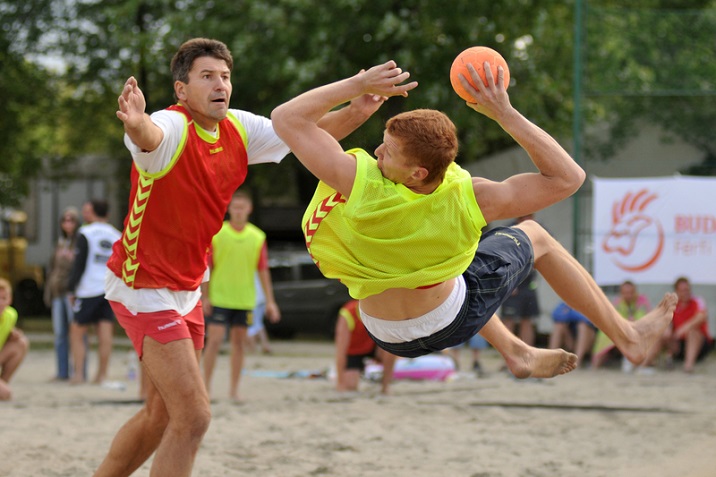
American Handball
Handball has been recreated in America and is known as American Handball. The dimension of the court is 40 by 20 feet. This playing area must be enclosed by a four walls. The main objective of the game is to bounce a small rubber ball off of the front wall. It can be played between two players each at both ends.
Handball - Tournaments
Handball tournaments are held every year in different countries. World Championship, Olympic Games, Summer Olympic, Asian Olympic, Common Wealth Games are the tournaments organised by international sports organizations.
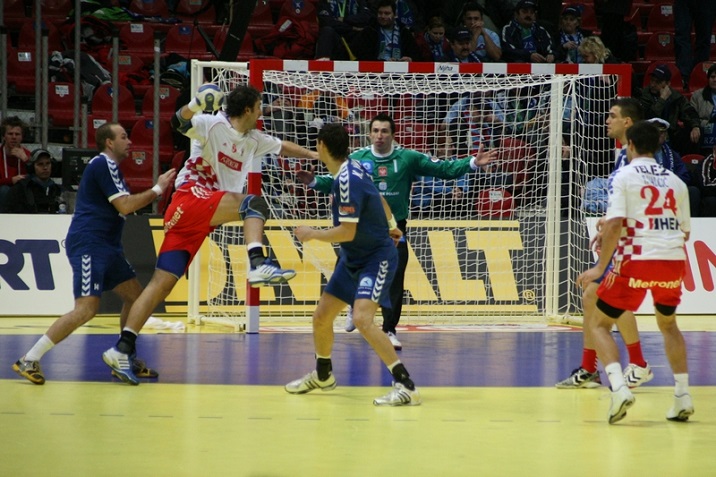
Apart from the above-mentioned major tournaments, handball tournaments are being organized at various places of the world, controlled by International Handball federation. Some handball tournaments organised at various place are given below.
| S.No. | Country & tournament |
|---|---|
| 1 |
Poland Polish Ekstraklasa Mens handball leagues also held for womens category. |
| 2 |
Spain Liga ASOBA. |
| 3 |
Sweden Elitserien (Both for Mens and Womens). |
| 4 |
Iceland Olis deil din |
| 5 |
United States U.S inter collegiate handball championship. |
| 6 |
India Indian handball super league. |
| 7 |
Denmark Jack and jones Ligaen. |
| 8 |
Germany Handball bundesliga. |
| 9 |
Grecce Greece Mens handball championship. |
| 10 |
Turkey Turkish handball super league. |
| 11 |
Scotland Scottish handball league. |
Handball - Champions
International Handball Federation is the governing body for various handball tournaments over the globe. In the first championship tournament only four teams participated, but now it has grown to a total membership of 24 teams. As handball gained popularity all over the globe, World Championship was planned and organized by IHF in a duration of every two years for both men and women category, since 1997.
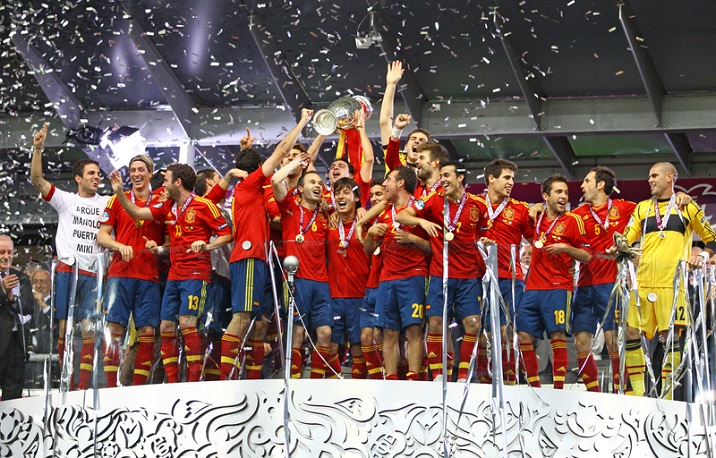
European countries have dominated since a long period of time. Since the formation of IHF, European Handball Federation has been organising various championship, which also serve as the qualifying tournament for the Olympics and the World championship, held at a hiatus of every two year. Sweden has won maximum number of championships whereas, Denmark has clinched maximum medals at the Olympics.